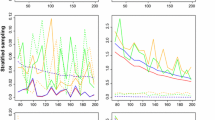Abstract
Filter questions with skip patterns have been widely used in survey research, and latent class models (LCM) are often used to analyze this type of categorical data. The LCM parameters are usually estimated by means of an EM (expectation maximization) algorithm. When the pattern is present, the non-response of the skip pattern cannot be treated as random missingness. We thus propose a modified algorithm to estimate the latent class parameters when non-response is present, and the approach is attractive for two reasons. First, the latent class model with the algorithm is very flexible in the sense that it can model the association of variables with the skip patterns under study. Secondly, the algorithm can be easily implemented using any computer language. An empirical example is used to demonstrate the usefulness of the algorithm. The algorithm may also be flexibly generalized to more complex surveys, for example, polytomous responses.
Similar content being viewed by others
References
Akaike H.: Information theory and an extension of the maximum likelihood principle. In: Petrov, B.N., Csake, F. (eds) Second international symposium on information theory, pp. 267–281. Budapest, Akademiai Kiado (1973)
Bozdogan H.: Model-selection and Akaike’s information criterion (AIC): the general theory and its analytical extensions. Psychometrika 52, 345–370 (1987)
Dayton C.M., Macready G.B.: A probabilistic model for validation of behavioral hierarchies. Psychometrika 41, 189–204 (1976)
Dayton C.M., Macready G.B.: A scaling model with response errors and intrinsically unscalable respondents. Psychometrika 45, 343–356 (1980)
Dayton C.M., Macready G.B.: Concomitant-variable latent-class models. J. Am. Stat. Assoc. 83, 173–178 (1988)
Dempster A.P., Laird N.M., Rubin D.B.: Maximum likelihood from incomplete data via the EM algorithm (with discussion). J. R. Stat. Soc. B. 39, 1–38 (1977)
Everitt B.S.: A Monte Carlo investigation of the likelihood ratio test for number of latent classes in latent class analysis. Multivariate Behav. Res. 23, 531–538 (1988)
Goodman L.A.: The analysis of multidimensional contingency tables: stepwise procedures and direct estimation methods for building models for multiple classifications. Technometrics 13, 33–61 (1971)
Goodman L.A.: Exploratory latent structure analysis using both identifiable and unidentifiable models. Biometrika 61, 215–231 (1974)
Goodman L.A.: A new model for scaling response patterns: an application for quasi-independence concept. J. Am. Stat. Assoc. 70, 755–768 (1975)
Goodman L.A.: Analyzing qualitative/categorical data: log-linear models and latent structure analysis. Abt Books, Cambridge (1978)
Hagenaars, J.A., McCutcheon, A.L. (eds): Applied Latent Class Analysis Models. Cambridge University Press, London (2002)
Lazarsfeld P.F., Henry N.W.: Latent Structure Analysis. Houghton Mifflin, Boston (1968)
Lin T.H., Dayton C.M.: Model selection information criteria for non-nested latent class analysis. J. Educ. Behav. Stat. 22, 249–264 (1997)
Magidson J., Vermunt J.K.: Latent Class Factor and Cluster Models, Bi-plots and Related Graphical Displays. Sociological Sociol. Methodol. 31, 223–264 (2001)
National Center for Health Statistics: National Health Interview Survey. ftp://ftp.cdc.gov/pub/Health_Statistics/NCHS/Survey_Questionnaires/NHIS/2004/english/QADULT.pdf (2004). Accessed 1 May 2007
Proctor C.H.: A probabilistic formation and statistical analysis of Guttman scaling. Psychometrika 35, 73–76 (1970)
Schafer J.L., Graham J.W.: Missing data: our view of the state of the art. Psychological Methods 7, 147–177 (2002)
Schwarz G.: Estimating the dimension of a model. Ann. Stat. 6, 461–464 (1978)
Ware J.E.J., Snow K.K., Kosinski M., Gandek B.: SF-36 Health Survey Manual and Interpretation Guide. Nimrod Press, Boston (1993)
Author information
Authors and Affiliations
Corresponding author
Rights and permissions
About this article
Cite this article
Lin, T.H. Estimating latent class model parameters for filter questions with skip patterns. Qual Quant 46, 545–552 (2012). https://doi.org/10.1007/s11135-010-9385-x
Published:
Issue Date:
DOI: https://doi.org/10.1007/s11135-010-9385-x




